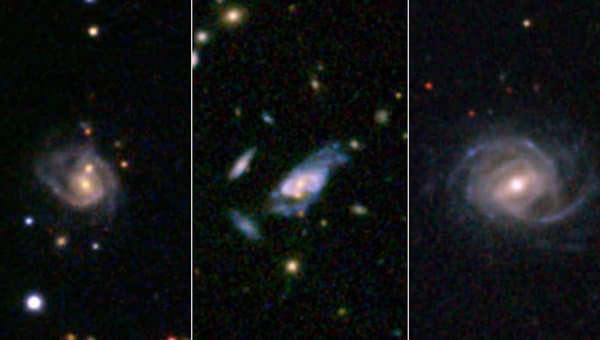Astronomers Discover Gigantic 'Super Spiral' Galaxies
Astronomers from NASA have discovered a massive spiral giant, very similar to our own Milky Way galaxy. Named as “Super Spiralâ€, this galaxy like beast was hidden from us for a long time owing to the presence of other similar looking galaxies.These huge objects are larger and more luminous than already identified galaxies.
According to Patrick Ogle, an astrophysicist from the Infrared Processing and Analysis Center (IPAC) at Caltech, these mysterious super spirals were recently discovered due to their attempt at making an online NASA/IPAC Extragalactic Database (NED) which contains information of about 100 million galaxies. From this package of information, scientists initially believed that the research would be guided strongly by elliptical galaxies, but out of 800,000 galaxies seemingly near to Earth, 53 of the brightest galaxies exhibit a spiral shape.

"super spiral" galaxies that dwarf our own spiral galaxy
As reported, Super spirals have 10 times the mass of the Milky Way and are 14 times brighter. They also emit ultraviolet and mid-infrared light which signifies star birth, 30 times more than the Milky Way. Interestingly, contemporary astrophysical theories contradict the results produced in the recent findings. Spiral galaxies are not supposed to be producing stars at the rate following the “quenching†limitation theory. However, spiral galaxies are working as exceptions.
The team reveals that out of 53 massive clusters, 4 contain two galactic nuclei instead of one. Double galactic nuclei signify the merging of two spiral galaxies, resulting in new elliptical galaxies. But, surprisingly the amalgamated gas-rich spiral galaxies settled down into another giant super spiral.
Source: #-Link-Snipped-#
According to Patrick Ogle, an astrophysicist from the Infrared Processing and Analysis Center (IPAC) at Caltech, these mysterious super spirals were recently discovered due to their attempt at making an online NASA/IPAC Extragalactic Database (NED) which contains information of about 100 million galaxies. From this package of information, scientists initially believed that the research would be guided strongly by elliptical galaxies, but out of 800,000 galaxies seemingly near to Earth, 53 of the brightest galaxies exhibit a spiral shape.

"super spiral" galaxies that dwarf our own spiral galaxy
As reported, Super spirals have 10 times the mass of the Milky Way and are 14 times brighter. They also emit ultraviolet and mid-infrared light which signifies star birth, 30 times more than the Milky Way. Interestingly, contemporary astrophysical theories contradict the results produced in the recent findings. Spiral galaxies are not supposed to be producing stars at the rate following the “quenching†limitation theory. However, spiral galaxies are working as exceptions.
The team reveals that out of 53 massive clusters, 4 contain two galactic nuclei instead of one. Double galactic nuclei signify the merging of two spiral galaxies, resulting in new elliptical galaxies. But, surprisingly the amalgamated gas-rich spiral galaxies settled down into another giant super spiral.
Source: #-Link-Snipped-#
0
